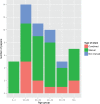The paradox of sham therapy and placebo effect in osteopathy: A systematic review
- PMID: 27583913
- PMCID: PMC5008597
- DOI: 10.1097/MD.0000000000004728
The paradox of sham therapy and placebo effect in osteopathy: A systematic review
Abstract
Background: Placebo, defined as "false treatment," is a common gold-standard method to assess the validity of a therapy both in pharmacological trials and manual medicine research where placebo is also referred to as "sham therapy." In the medical literature, guidelines have been proposed on how to conduct robust placebo-controlled trials, but mainly in a drug-based scenario. In contrast, there are not precise guidelines on how to conduct a placebo-controlled in manual medicine trials (particularly osteopathy). The aim of the present systematic review was to report how and what type of sham methods, dosage, operator characteristics, and patient types were used in osteopathic clinical trials and, eventually, assess sham clinical effectiveness.
Methods: A systematic Cochrane-based review was conducted by analyzing the osteopathic trials that used both manual and nonmanual placebo control. Searches were conducted on 8 databases from journal inception to December 2015 using a pragmatic literature search approach. Two independent reviewers conducted the study selection and data extraction for each study. The risk of bias was evaluated according to the Cochrane methods.
Results: A total of 64 studies were eligible for analysis collecting a total of 5024 participants. More than half (43 studies) used a manual placebo; 9 studies used a nonmanual placebo; and 12 studies used both manual and nonmanual placebo. Data showed lack of reporting sham therapy information across studies. Risk of bias analysis demonstrated a high risk of bias for allocation, blinding of personnel and participants, selective, and other bias. To explore the clinical effects of sham therapies used, a quantitative analysis was planned. However, due to the high heterogeneity of sham approaches used no further analyses were performed.
Conclusion: High heterogeneity regarding placebo used between studies, lack of reporting information on placebo methods and within-study variability between sham and real treatment procedures suggest prudence in reading and interpreting study findings in manual osteopathic randomized controlled trials (RCTs). Efforts must be made to promote guidelines to design the most reliable placebo for manual RCTs as a means of increasing the internal validity and improve external validity of findings.
Conflict of interest statement
The authors have no funding and conflicts of interest to disclose.
Figures
Similar articles
-
Systemic pharmacological treatments for chronic plaque psoriasis: a network meta-analysis.Cochrane Database Syst Rev. 2021 Apr 19;4(4):CD011535. doi: 10.1002/14651858.CD011535.pub4. Cochrane Database Syst Rev. 2021. Update in: Cochrane Database Syst Rev. 2022 May 23;5:CD011535. doi: 10.1002/14651858.CD011535.pub5. PMID: 33871055 Free PMC article. Updated.
-
Eliciting adverse effects data from participants in clinical trials.Cochrane Database Syst Rev. 2018 Jan 16;1(1):MR000039. doi: 10.1002/14651858.MR000039.pub2. Cochrane Database Syst Rev. 2018. PMID: 29372930 Free PMC article.
-
Drugs for preventing postoperative nausea and vomiting in adults after general anaesthesia: a network meta-analysis.Cochrane Database Syst Rev. 2020 Oct 19;10(10):CD012859. doi: 10.1002/14651858.CD012859.pub2. Cochrane Database Syst Rev. 2020. PMID: 33075160 Free PMC article.
-
Systemic pharmacological treatments for chronic plaque psoriasis: a network meta-analysis.Cochrane Database Syst Rev. 2017 Dec 22;12(12):CD011535. doi: 10.1002/14651858.CD011535.pub2. Cochrane Database Syst Rev. 2017. Update in: Cochrane Database Syst Rev. 2020 Jan 9;1:CD011535. doi: 10.1002/14651858.CD011535.pub3. PMID: 29271481 Free PMC article. Updated.
-
Herbal and dietary therapies for primary and secondary dysmenorrhoea.Cochrane Database Syst Rev. 2001;(3):CD002124. doi: 10.1002/14651858.CD002124. Cochrane Database Syst Rev. 2001. Update in: Cochrane Database Syst Rev. 2016 Mar 22;3:CD002124. doi: 10.1002/14651858.CD002124.pub2. PMID: 11687013 Updated.
Cited by
-
Clinical relevance of contextual factors as triggers of placebo and nocebo effects in musculoskeletal pain.BMC Musculoskelet Disord. 2018 Jan 22;19(1):27. doi: 10.1186/s12891-018-1943-8. BMC Musculoskelet Disord. 2018. PMID: 29357856 Free PMC article. Review.
-
Osteopathic Medicine in Four Chronic Musculoskeletal Pain Diseases: An Observational Trial with Follow-Up.Complement Med Res. 2022;29(1):53-66. doi: 10.1159/000518311. Epub 2021 Aug 19. Complement Med Res. 2022. PMID: 34515079 Free PMC article.
-
Osteopathic Manipulative Treatment as an Intervention to Reduce Stress, Anxiety, and Depression in First Responders: A Pilot Study.Mo Med. 2021 Sep-Oct;118(5):435-441. Mo Med. 2021. PMID: 34658436 Free PMC article.
-
The Effects of Osteopathic Manipulative Treatment on Brain Activity: A Scoping Review of MRI and EEG Studies.Healthcare (Basel). 2024 Jul 6;12(13):1353. doi: 10.3390/healthcare12131353. Healthcare (Basel). 2024. PMID: 38998887 Free PMC article.
-
Manual Therapy Effect in Placebo-Controlled Trials: A Systematic Review and Meta-Analysis.Int J Environ Res Public Health. 2022 Oct 28;19(21):14021. doi: 10.3390/ijerph192114021. Int J Environ Res Public Health. 2022. PMID: 36360901 Free PMC article.
References
-
- Kaptchuk TJ, Miller FG. Placebo effects in medicine. N Engl J Med 2015; 373:8–9. - PubMed
Publication types
MeSH terms
LinkOut - more resources
Full Text Sources
Other Literature Sources



